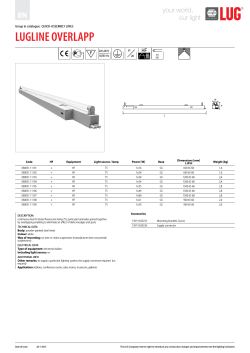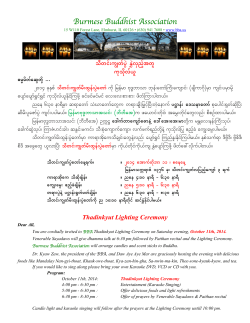
Integrating the Internet of Awareness into our Smart Lighting
Technical Article Integrating the Internet of Awareness into our Smart Lighting Systems Sensing, controlling and connecting our lighting systems By Tom Griffiths Marketing Manager, Sensor Driven Lighting, ams AG www.ams.com The phrase “Internet of Things” or IoT, is being used so often that it would be easy to write it off as simply the latest buzzword for things with IP addresses. While the age of ubiquitous internet-connected toasters is not quite upon us, the next era of device interconnectivity certainly is here now, and the coming growth of “connectedness” is undeniable. All we have to do is look into our pockets and see smartphones, when combined with apps and the cloud, knowing where we are and already predicting what we might be doing, or more to the commercial point, what might be interesting to us. The point of this connectedness is to create more interaction with the space around us. As we drive by the local shopping center, apps such as RetailMeNot will push offers and coupons at us. While initially somewhat random, it doesn’t take long for the cloud-based servers to begin to correlate what e-coupons we actually use, and where we use them, with details that include the time of day, the day of the week, our location, and what other coupons we’ve used in the proximity. This successful data-mining might initially seem intrusive, but as the app adapts to the individual user’s patterns, more and more of the offers begin to actually fit our lifestyle, predicting when we’re in the shopping mode, and what we might actually be shopping for. At that point, the connectedness moved from simple advertising into becoming a value service. In the same way, the spaces we occupy, the so-called “microspaces” in our daily lives most often our office or home, are poised to become the primary value delivery point for IoT value services. And while all those “things” in the IoT will be ready and willing to respond to our preferences and needs, they’ll need more than just our ID and location for the IoT to be of value to us. The things will need to know about the space, and what is going in inside it. An Internet of Awareness will need to be created to complement the Internet of Things. Those microspaces will need sensors. Page 1 / 7 Technical Article Enter the Real Age of Awareness Our built environments have some very common ingredients, including walls, windows, furnishings, HVAC systems and lighting. Due to the combination of its “hardwired” electrical nature, and its ubiquity across our microspaces, lighting is the natural system through which to host many of the sensor systems that create the Internet of Awareness that will enable the IoT. While the concept of connected lighting doesn’t sound particularly earthshaking, the reality is that very few of today’s lighting installations can really be called “connected”. A modern building management system may be able to command banks of light on or off in a prescribed schedule, tally the overall trend of occupancy sensor triggers in a series of spaces, or may even be able to infer the amount of energy usage/savings that those events trigger, but things pretty much stop there. In reality, prior to the start of the solid state (or LED) lighting revolution, there really wasn’t much to control beyond on and off. Fig. 1: Possibilitiy of a connected lighting installation Recent component advances are enhancing both the capabilities and connectedness of our lighting, providing a preview of the coming tsunami of sensor driven awareness that will include not only information on lighting levels and energy usage, but data that will encompass everything from air quality and space utilization to the wearable-transmitted vital signs of the users of those spaces. Page 2 / 7 Technical Article Fig. 2: Sensors enable task tuning, daylight harvesting, color tuning and occupancy detection The Hierarchy of Embedding Awareness – Step 1: Sense It The whole point of the Internet of Awareness is sensing, so the critical determiner of any architecture will be what we intend to sense. The architecture example below begins from integrated occupancy and ambient light sensing as part of a smart lighting manager, on top of which the system integrator can add such things as temperature, humidity, CO/CO2, motion and presence. Some of these sensor additions, such as direction of travel motion/presence, are useful information for the lighting system, while others are pass-through information that will be provided in response to BMS queries for the data. Page 3 / 7 Technical Article Fig. 3: Architecture example of a next generation luminaire system To facilitate sensor extensibility, industry standard platforms should be considered. In the example above, I2C has been chosen for core expansion. Simple UART-based connectivity, such as RS485, can also be employed, with or without distributed intelligence, the need for which would be driven by the frequency and volume of the sensor data being captured. Whether you look at it as ‘sensors, with intelligence at no extra charge’, or vice versa, the simplest approach for widely distributed sensing will be a single dedicated controller which includes one or more integrated sensors. Step 2: Control It In terms of both performance and cost, there are many different aspects of a next generation luminaire that benefit from sensors and local control. Once we know what we’re going to sense, Step 2 in the development of the Internet of Awareness becomes control of our lighting system. Welcome to smart lighting. Given the lighting industry’s century-long track record of simply needing to bring the specified voltage (directly or through a ballast) to a socket into which a bulb was installed, the move to engineering, rather than just mechanically integrating light sources, is proving to be a painful to many of the players. A standard approach is often to delegate the LED light engine and power system designs to knowledgeable suppliers who can deliver an off-the-shelf or semi-custom plug and play solution. As market requirements move forward, more than a few of the thousands of lighting manufacturers have been left wondering how they add California Title 24 compliant daylight responsiveness into a subsystem they didn’t really engineer in the first place. With the coming need to engineer our lighting into the IoT, implementing a truly extensible sensing and IoT capable lighting system can add an order of magnitude to the challenge. Fortunately, challenge equates to opportunity, and the semiconductor industry is poised to ride in to the rescue. Page 4 / 7 Technical Article Fig. 4: Example of a sensor-driven smart lighting manager that illustrates basic control within the luminaire New sensor-fused intelligent component solutions which can simply be inserted between the luminaires and their existing control points, such as dimmers and occupancy sensors, are arriving now. The example above illustrates one example of a sensor-driven smart lighting manager that illustrates basic control within the luminaire. In this architecture, the smart lighting manager is placed between the 0-10V dimmer control and the LED or fluorescent luminaire’s 0-10V dimming input to the ballast. In this most basic intelligence-enabled luminaire, sliding the dimmer opens the control loop, directly varying the fixture’s lumen output, which changes the illumination level of the space. Once adjustment is completed, the built-in daylighting sensor reads the resulting lux (lumens per square meter) of the target space, and enters a closed-loop control mode that will maintain that new target lux. As daylight enters the space, the luminaire’s output is seamlessly adjusted to keep that constant lux on the target. Over the long term, as the fluorescent lamps or LED emitters experience their normal lumen depreciation, or even as the fixture gets dusty, the closed loop nature of the system will also adjust the luminaire output to simply maintain the lux in the target space regardless of the changing nature of the emission source. Step 3: Connect It An extensible lighting manager added to the system will also provide a connection point to off-theshelf networking options, making the otherwise daunting task of connecting the individual luminaires to the IoT a manageable challenge. Adding on to the example from above, the smart lighting manager in the illustration below provides a serial UART connection which provides a straightforward connection to standard networking platforms. Borrowing some ideas from the Hayes modem days the manager responds through the UART to simple AT-type text commands, creating a driverless command interface. The network component provider will have done the heavy lifting that implements the stacks and protocols for such popular wireless connectivity approaches as Bluetooth (BLE/Smart), WiFi, and ZigBee, as well as wired versions including Ethernet. Application level embedded or reference code from the lighting manager supplier then bridges the gap between the network controller and the lighting manager, as well providing any needed hooks to a core set of additional controls or protocols that can be expected to make use of the UART connection, including DALI (a primarily European lighting control standard) or even good old RS-485. With reference design approaches, a delivered integration kit will include Bluetooth connectivity to an Android or iPhone or wired connectivity that implements text-based commands such as Set_Lux_Target, Read_Lux_Level or Set_Luminaire_Output_Level (with GUI-based scrolls, selectors or sliders, of course). Page 5 / 7 Technical Article Fig. 5: Connection of the smart lighting manager to the system And Then… Evolve It The basic definition of smart lighting implies, at a minimum, luminaire-centric sensing and control. As we have seen in example after example, from our entertainment devices to our automobiles, once intelligence is introduced and semiconductor technologies can be turned loose on high-volume solutions, the costs scale down while the value-added features and capabilities scale up with only minor increments in cost. As the basic smart lighting architecture is put in place in most luminaires and in every space, the evolution of the smart lighting sensor hub will move at a rapid pace. As cost-effective processing power increases, items such as arrayed presence detection will be enhanced to include detailed people counting and direction of travel and dwell time information, all compiled and summarized for the BMS to use in broader space planning. Individualized data will also be incorporated into self-learning approaches which will then optimize the space around us in a variety of ways. Our personal wearable technologies, whether the simple RFID in our badge or more complex data communication from our bio-monitoring smart watch, will be used to correlate our presence and status with our learned preferences to deliver everything from customized lighting scenes to optimized temperature and humidity levels. All of these capabili- Page 6 / 7 Technical Article ties will come without a significant added cost, courtesy of the cognition available from our intelligent sensor-integrated smart lighting systems serving as sensor hubs for the coming Internet of Awareness. For further information ams AG Tom Griffiths Marketing Manager, Sensor Driven Lighting Tel: +1 512 330 912921 thomas.griffiths@ams.com www.ams.com Page 7 / 7
© Copyright 2025










